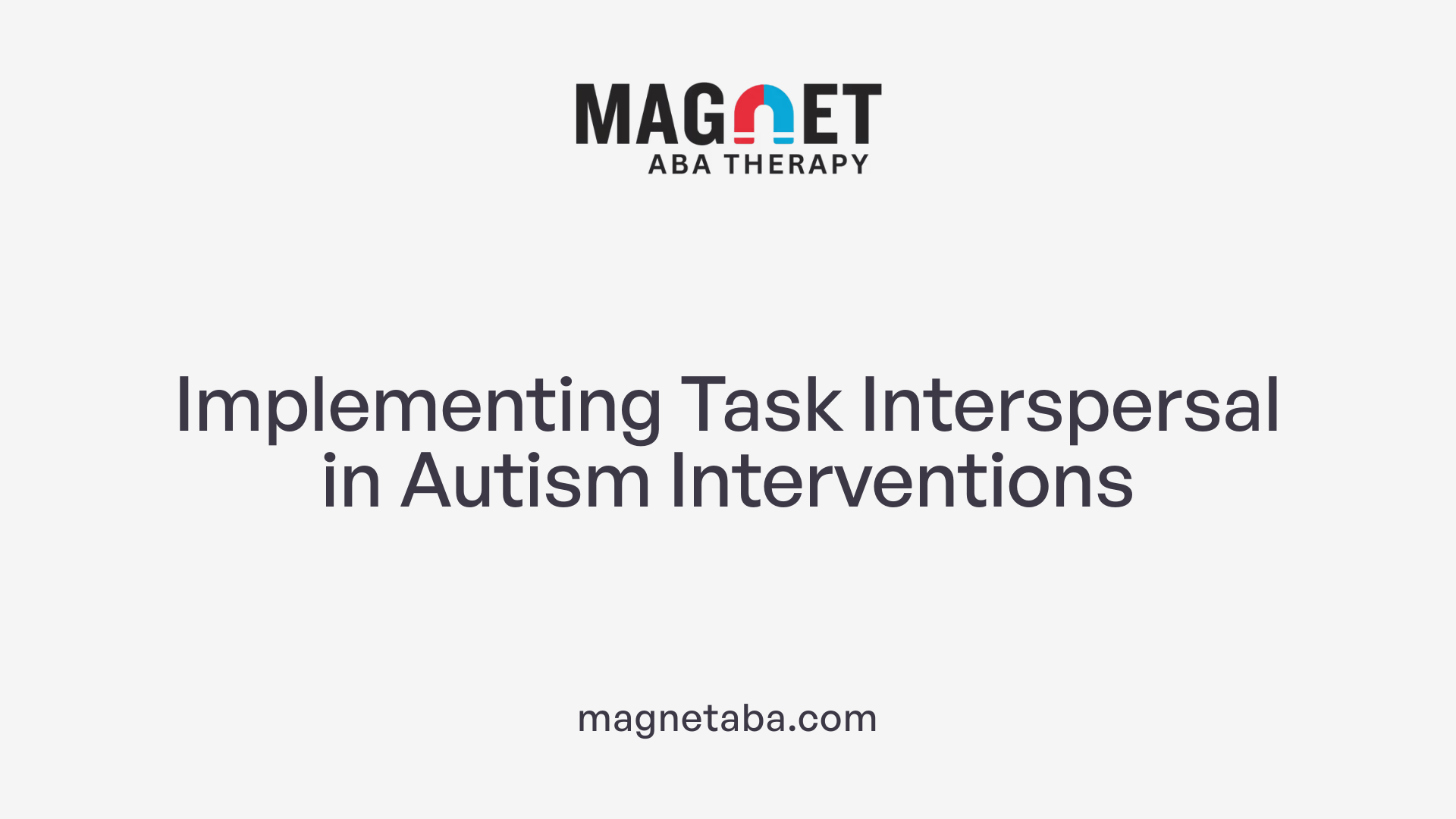Understanding the Foundations of Task Interspersal in Behavioral Education
Task interspersal is a versatile instructional strategy widely utilized in interventions for individuals with autism spectrum disorder (ASD). Its core purpose is to improve learning efficiency, boost motivation, and promote skill generalization by carefully mixing different tasks within a teaching session. This article explores what task interspersal is, when and why it is especially useful, how it is applied in behavior analysis and autism interventions, and the key benefits of implementing this approach effectively.
Defining Task Interspersal and Its Purpose

What is task interspersal?
Task interspersal is a teaching strategy designed to enhance learning by mixing different types of tasks within a single instructional session. Rather than focusing solely on new or challenging skills, this method combines tasks of varying levels of difficulty—such as mastered, unlearned, or preferred activities—and intermingles them throughout teaching periods.
This approach is especially common in interventions for individuals with autism spectrum disorder (ASD). Its goal is to increase motivation, sustain engagement, and improve skill retention by creating an environment with diverse, manageable learning experiences.
In practice, task interspersal involves selecting tasks carefully and applying reinforcement strategies, often utilizing a ratio where several maintained or preferred tasks are alternated with targeted learning tasks. For example, a common ratio used by providers is 3:1, meaning three tasks of known or preferred difficulty are interspersed for every one new or challenging task.
The core principle behind task interspersal is to promote behavioral momentum. Rewarding or engaging with familiar tasks encourages compliance and reduces problem behaviors such as noncompliance, aggression, or self-injury. It also leverages the natural human tendency to respond more positively to varied but predictable activity patterns.
Core principles of the method
- Mixing Tasks of Different Difficulties: Alternating between mastered or preferred tasks and less familiar or more challenging tasks to keep motivation high.
- Maintaining Engagement: Using high-preference tasks to reinforce participation and decrease problem behaviors.
- Managing Reinforcement: Applying differential reinforcement schedules that support learning while preventing satiation—keeping reinforcers effective.
- Flexibility in Implementation: Adjusting ratios, task domains, and reinforcement based on individual needs, often guided by clinical judgment or organizational policies.
- Focus on Maintenance and Acquisition: Combining tasks that the learner can consistently perform (maintenance) with new or unmastered skills (acquisition) to facilitate generalization.
Target populations for use
Task interspersal is primarily used with individuals with ASD, including children in preschool settings and older learners. It has proven effective for various skill domains, such as:
| Skill Domain | Examples of Skills Taught | Benefits in Intervention |
|---|---|---|
| Motor Skills | Gross and fine motor tasks | Improve coordination and accuracy |
| Food Acceptance | Trying new foods, increasing intake | Reduce food selectivity and encourage healthy eating |
| Tacting and Labeling | Identifying objects, people, or actions | Enhance expressive language and categorization skills |
| Visual Matching | Matching pictures or objects | Build foundational cognitive skills |
| Following Instructions | Completing multi-step commands | Increase independence in daily routines |
Research indicates that utilizing maintenance tasks within the interspersal framework is supported by empirical evidence, promoting better retention and adherence to learned skills. The method's flexibility makes it adaptable across various domains and individual learner needs.
In summary, task interspersal is a versatile, evidence-based teaching approach that strategically combines varying tasks to maximize engagement, motivation, and learning efficiency, particularly beneficial for learners with ASD.
When and Why Task Interspersal Is Useful

When is task interspersal useful in behavioral interventions?
Task interspersal plays a significant role in behavioral strategies, especially when working with individuals with autism spectrum disorder (ASD). It is primarily utilized to promote the generalization of skills across different settings and tasks, enhance student engagement, and reduce problematic behaviors such as noncompliance or aggression.
This teaching method involves mixing mastered (or highly preferred) tasks with less familiar or unlearned tasks within a session. Using a typical ratio like 3:1—three tasks of known or highly obtainable skills to one new or less familiar task—helps sustain motivation and encourages continued participation.
In practice, task interspersal usually involves alternating between tasks that vary in complexity or familiarity, fostering a positive learning environment. For example, a speech therapist might alternate between a simple tacting task and a more complex verbal response to keep the child engaged.
This approach is especially effective when teaching discrete responses, which are individual, clearly defined behaviors. Mixing tasks of varying difficulty can improve overall learning rates, maintain motivation, and promote skill retention.
Furthermore, interspersal is particularly beneficial when introducing new skills. Pairing these with well-established behaviors that the individual already enjoys or responds accurately to can facilitate faster acquisition and reduce frustration.
Typically, the procedure involves a deliberate selection of tasks according to individual needs and abilities. The goal is to build momentum by successfully completing known tasks before addressing unfamiliar ones.
However, it is important to recognize that task interspersal may not be as effective for complex, chained behaviors such as reading multi-paragraph texts. These responses require specific instructional approaches focused on chains or sequences.
In summary, task interspersal is a valuable and adaptable strategy in behavioral intervention, particularly effective for promoting learning, engagement, and behavior compliance in individuals with ASD. Its application should be tailored to individual profiles and targeted behaviors to maximize benefits.
Application in Behavior Analysis and Autism Interventions

How is task interspersal applied in behavior analysis and autism interventions?
Task interspersal is a widely used teaching strategy in the field of behavior analysis, especially for individuals with autism spectrum disorder (ASD). It involves mixing different tasks or activities within a single instructional session to enhance learning, promote generalization of skills, and reduce behavioral issues such as rigidity or boredom.
Typically, this method combines both maintenance and acquisition targets. Maintenance tasks are those the individual has already learned and can perform reliably, while acquisition tasks are new or non-mastered skills that need to be learned.
One common approach is the 3:1 ratio, where three tasks of known or preferred difficulty are interspersed with a single target task. For example, a learning session might include three highly preferred matching tasks, followed by one new or difficult matching task. This ratio helps sustain motivation and engagement, making it easier for learners to acquire new skills.
Research indicates that interspersing tasks from various skill domains—such as motor skills, language, or social skills—can effectively promote retention and generalization. For instance, a study involving preschool children with autism demonstrated that including mastered stimuli alongside non-mastered ones significantly increased the correct responses to the latter.
Interspersal often utilizes tasks that are brief, highly preferred, and associated with high accuracy. This strategy helps maintain student engagement and reduces the likelihood of problem behaviors like noncompliance or aggression.
Reinforcement plays a crucial role within this strategy. Differentiated reinforcement schedules—such as continuous reinforcement for new responses and intermittent reinforcement for mastered tasks—can enhance learning outcomes. Adjusting reinforcement based on individual responsiveness further personalizes the intervention.
Studies show that reinforcement strategies, when combined with task interspersal, can lead to notable improvements in response acquisition, retention, and overall on-task behavior. For example, one study with preschool children found that manipulating reinforcement schedules during interspersal sessions increased correct responses to non-mastered stimuli and maintained these gains even after reducing reinforcement density.
Overall, applying task interspersal in behavior analysis involves a systematic, individualized process. It requires careful selection and balancing of tasks, reinforcement strategies, and procedural ratios to optimize learning for each learner.
Variations in procedural implementation
Behavior analysts and educators often tailor task interspersal procedures based on organizational guidelines, clinical judgment, and ongoing assessment of individual progress. Variations may include the choice of interspersal ratios, the specific skill domains included, and the reinforcement schedules.
Many practitioners rely on a ratio of 3:1, interspersing three tasks of similar difficulty with one target task. Tasks used are generally brief and highly preferred to sustain motivation. Reinforcement schedules can vary from continuous to more intermittent patterns, depending on the learner’s response and the goals of intervention.
Procedural choices, such as whether to intersperse tasks within the same domain (e.g., all language skills) or across different domains (e.g., motor and social skills), are often guided by clinical experience rather than strictly scientific evidence. Variations can also include the use of different reinforcement strategies—for example, alternating reinforcement schedules for different tasks—aimed at maximizing learning and engagement.
Additionally, some providers prioritize including maintenance tasks among acquisition targets to prevent satiation and promote retention. Adjustments are often made based on the learner's behavior, motivation, and progress, emphasizing the importance of individualization.
Role of clinical judgment and scientific literature
While scientific research supports the effectiveness of task interspersal, especially with the strategic mixing of mastered and unmastered tasks, many practitioners rely more heavily on clinical judgment, organizational guidelines, and personal experience when designing procedures.
There is a recognized need for greater integration of empirical findings into everyday practice. For example, research indicates that interspersing maintenance tasks with acquisition targets can be particularly effective, but the specific implementation details—such as task difficulty balance and reinforcement timing—are often guided by the clinician’s judgment.
Supervisors and organizations are encouraged to stay updated with current scientific literature to inform best practices. Emphasizing training and decision-making based on empirical evidence can improve intervention outcomes.
In summary, while procedural flexibility is common and sometimes necessary, grounding individualization and modifications in existing research can help optimize the benefits of task interspersal for learners with ASD.
Implementing Task Interspersal: Strategies and Guidelines

What are the benefits and how can task interspersal techniques be implemented?
Task interspersal is a teaching strategy that involves mixing different types of tasks within a session to make learning more engaging and effective for individuals with autism spectrum disorder (ASD). The main benefits include improving retention of skills, decreasing fatigue, boosting motivation, and promoting better generalization of learned skills to natural settings.
Implementing task interspersal effectively requires carefully planning how tasks are scheduled throughout a session. This typically involves alternating between easier, mastered tasks and more challenging, non-mastered tasks. For example, a session may include three trials of a target skill followed by a brief, preferred activity or a mastered task. This ratio helps maintain the learner’s interest and reduces the likelihood of problem behaviors like noncompliance or agitation.
Research with preschool children with autism shows that interspersing tasks—such as mixing mastered and non-mastered matching activities—can significantly increase correct responses. Such strategies have also shown to support learning even after adjustments are made to reinforcement schedules, indicating their lasting effectiveness.
To maximize the benefits, it is crucial to match the interspersed tasks to the individual learner’s skill level and interests. Incorporating highly preferred, brief activities or mastered skills that promote success can reinforce engagement. Additionally, tailoring the reinforcement schedule—such as using continuous reinforcement for acquisition tasks while varying reinforcement for maintenance tasks—can enhance learning outcomes.
In practice, careful scheduling, continuous monitoring, and individualization are vital for successful task interspersal. Using empirical evidence as a foundation, educators and therapists are encouraged to design sessions that include a strategic mix of tasks, reinforcement, and pacing suited to each learner’s needs. These strategies help create a motivating and effective learning environment capable of fostering durable skill acquisition.
Selection of tasks and reinforcement strategies
Effective task interspersal relies heavily on choosing appropriate tasks and reinforcing behaviors suitably. Tasks are often selected based on the learner’s current skill level and interests. Highly preferred and easy tasks, such as those already mastered or intrinsically motivating, are ideal for interspersing because they boost motivation and provide quick success.
Reinforcement strategies should be individualized, with differentiated reinforcers for acquisition versus maintenance tasks. For example, continuous reinforcement—where every correct response is rewarded—can be used during acquisition of new skills, ensuring rapid learning. For maintenance tasks, reinforcement schedules may be varied to promote generalization and independence.
Procedural variations and ratios
Practitioners often vary procedural aspects of task interspersal based on clinical judgment or organizational guidelines. Variations include interspacing different types of tasks—such as those from different skill domains—or adjusting the ratio of interspersed tasks to target tasks.
The most common ratio is 3:1, meaning three interspersed tasks are presented for every targeted skill. Adjusting this ratio allows for tailoring the difficulty and pacing of sessions to each learner.
Research indicates that interspacing maintenance (well-known skills) among acquisition (new skills) tasks tends to be especially effective. However, outcomes can vary based on specific procedural choices, such as the types of tasks, reinforcement schedules, and the learner’s individual characteristics.
Importance of individualization
Despite a general evidence base supporting task interspersal, implementation often relies on clinical judgment rather than strict adherence to scientific guidelines. It is essential to individualize procedures to match each learner’s unique needs, preferences, and learning style.
Behavior analysis training influences how providers implement these procedures, which highlights the need for ongoing professional development supported by current research. Supervisors and organizations should update protocols regularly, ensuring practices are based on the latest empirical findings.
In conclusion, while variability exists in how task interspersal is applied, the overall evidence supports its use for promoting engagement, learning, and behavior reduction. Thoughtful selection, procedural adjustments, and individualization remain central to maximizing its benefits in educational and therapeutic settings.
Procedural Variations and Reinforcement Schedules in Task Interspersal
What procedural variations are common in task interspersal?
In practice, professionals often modify how they implement task interspersal to suit individual learners’ needs. Variations include the interspersal ratio, the types of tasks chosen, and the reinforcement schedules used.
Many providers utilize a ratio of 3:1, meaning they intersperse three tasks of known or preferred difficulty for every one target task. This ratio helps maintain motivation and engagement, especially when tasks are similar in difficulty.
Procedural differences also appear in the selection of task domains. Providers often mix tasks that span different skill areas, such as motor skills, communication, or matching, to encourage broader learning.
Reinforcement schedules are another area with variation. Some practitioners employ continuous reinforcement for acquisition tasks, ensuring immediate reinforcement each time a response occurs. Meanwhile, reinforcement for maintenance or preferred tasks may be differentiated to sustain motivation and facilitate learning.
Furthermore, adjustments in the types of tasks, their difficulty levels, and reinforcement are often guided more by clinical judgment than strictly by scientific guidelines. This flexibility allows for tailoring the intervention to individual student needs, although it also introduces variability.
How do task domain considerations influence interspersal?
Providers sometimes intersperse tasks from different domains to promote overall skill development and prevent boredom. Tasks that are familiar or highly preferred are included to reinforce motivation and increase the likelihood of successful engagement.
While many use similar difficulty tasks, the inclusion of diverse task domains can pose challenges in maintaining a consistent learning pace. Therefore, balancing various domains within the interspersal framework helps optimize outcomes.
How do reinforcement schedule adjustments impact intervention?
Reinforcement plays a pivotal role in the success of task interspersal. Studies suggest that using continuous reinforcement for learning new or non-mastered tasks enhances learning rates.
Differentiated reinforcement, where highly preferred or mastered tasks are reinforced differently from acquisition tasks, can maintain motivation and minimize satiation. Adjustments in reinforcement frequency and type are often personalized based on the learner’s responsiveness.
In summary, procedural variations—such as interspersal ratios, task domain selection, and reinforcement schedules—provide flexibility to adapt to individual learner profiles. These variations are supported by empirical findings but are frequently guided by clinical judgment to optimize skill acquisition and behavior throughout the intervention.
| Variation Type | Description | Typical Use Cases |
|---|---|---|
| Interspersal Ratio | The number of tasks between target responses, e.g., 3:1 | Maintaining engagement, balancing learning and motivation |
| Task Domain Selection | Mixing different skill areas or difficulty levels | Broad skill development, preventing monotony |
| Reinforcement Schedule | Continuous vs. intermittent, differentiated reinforcement strategies | Enhancing learning, sustaining motivation |
Understanding these procedural variations allows practitioners to customize interventions effectively, leveraging research evidence and individual client needs.
Individualization and Professional Judgment in Implementation
How is individualization incorporated into task interspersal practices?
Personalizing task interspersal procedures to suit each learner’s unique characteristics is essential for maximizing effectiveness. Despite its importance, this individualized approach is not consistently applied across practitioners. Providers should emphasize tailoring the intervention based on specific client needs, strengths, and behaviors to enhance learning outcomes.
The decision-making process for procedural variations, such as task difficulty, interspersal ratios, and reinforcement schedules, can be significantly influenced by a provider’s training background. For example, those with extensive behavior analysis training may be more inclined to implement evidence-based practices that align closely with scientific literature.
Many professionals tend to rely more heavily on organizational guidelines and clinical judgment rather than current scientific evidence. While these sources can be valuable, integrating empirical research findings into practice can improve accuracy and outcomes.
It is recommended that practitioners focus more on customizing interventions based on individual learner profiles and aligning their methods with ongoing research. Doing so not only enhances the effectiveness of task interspersal strategies but also supports ethical and client-centered practice.
Implementing a personalized approach involves assessing each learner’s previous skills, preferences, and behavioral responses. This information guides adjustments such as using reinforcement schedules that are most motivating or selecting tasks of appropriate difficulty levels. The goal is to foster engagement, improve retention, and decrease problem behaviors like noncompliance or aggression.
In summary, the ability to adapt and individualize task interspersal procedures plays a crucial role in positive behavioral outcomes. Training programs and organizational policies should prioritize including current scientific evidence and emphasizing the importance of tailoring interventions to each learner's unique characteristics.
Empirical Evidence Supporting Task Interspersal

What evidence exists for the effectiveness of task interspersal?
Research provides strong support for using task interspersal as a teaching strategy for individuals with autism spectrum disorder (ASD). Studies have tested various forms of interspersal, often alternating improved or mastered tasks with new or non-mastered ones. Results consistently show that this approach increases correct responses and enhances skills across different domains, such as motor skills, food acceptance, tacting, visual matching, and following instructions.
A common procedural approach involves interspersing a ratio of three tasks for every one target skill, mixing tasks that are of similar difficulty or from different skill domains. This ratio helps maintain student engagement and motivation. For example, when students are presented with mastered or highly preferred tasks between less mastered ones, their correct response rate improves. Evidence indicates that such mixing not only supports skill acquisition but also boosts overall engagement and compliance.
Research has also demonstrated that the positive effects of task interspersal are sustained even when reinforcement density is reduced. This suggests the method's usefulness for promoting longer-term learning and independence. One study involving preschool children with autism found that implementing interspersal increased correct responses to non-mastered stimuli. These gains persisted through sessions with less frequent reinforcement, highlighting the model's durability.
Furthermore, empirical data suggests that implementing interspersal with maintenance tasks can minimize problem behaviors like noncompliance or aggression. When maintenance tasks are included alongside acquisition tasks, learners tend to show better on-task behavior and fewer disruptive responses.
Impact of reinforcement schedules
The reinforcement schedule used during task interspersal significantly influences outcomes. For targeted learning, continuous reinforcement of acquisition tasks has been shown to be effective, especially when combined with differentiated reinforcement for maintenance tasks. For example, providing consistent reinforcement for correct responses on new or non-mastered tasks helps accelerate learning.
Studies comparing various reinforcement schedules indicate that combining continuous reinforcement for new tasks with intermittent reinforcement for mastered or maintenance tasks maintains motivation and reduces satiation. Adjusting reinforcement based on individual learner preferences and performance can further optimize the effectiveness of task interspersal.
Overall, the scientific literature affirms that carefully designed task interspersal procedures—particularly those incorporating mastered tasks and strategic reinforcement—are effective in promoting skill acquisition, retention, and behavioral improvements in learners with ASD.
Key Challenges and Considerations for Practitioners
What are the challenges in implementing task interspersal effectively?
Implementing task interspersal can present several hurdles for practitioners. First, many providers rely on procedural variations grounded more in clinical judgment or organizational guidelines than in current scientific evidence. This inconsistency can lead to variability in how the method is applied across different settings, potentially affecting its overall effectiveness.
Another challenge is balancing the need for procedural consistency with individualized approaches tailored to each learner's unique needs. Since learners with autism spectrum disorder (ASD) vary widely in their responses and preferences, customizing strategies like task interspersal becomes essential but often difficult to execute effectively.
Proper training and ongoing supervision are critical factors in overcoming these issues. Staff must be equipped with up-to-date knowledge of empirical research and best practices to implement task interspersal correctly. Supervisors play a vital role in guiding practitioners, ensuring fidelity to effective procedures, and adapting interventions based on learner responses.
Furthermore, variability in treatment outcomes can sometimes stem from inconsistent application of reinforcement schedules, choice of tasks, and interspersal ratios. For example, research suggests that interspersing tasks of different difficulty levels and using appropriate reinforcement strategies improves learning and engagement. However, providers often default to using tasks of similar difficulty, which may lessen the intervention's benefits.
Addressing these challenges requires continuous evaluation and adjustment of techniques. Practitioners should regularly assess learner progress and modify procedures accordingly, aligning their methods with the latest scientific evidence. Moreover, organizations should provide clear, research-informed guidelines to promote consistent and effective use of task interspersal.
In summary, effective implementation involves harmonizing scientific research with individual learner needs, investing in staff training, and maintaining a flexible yet consistent approach that adapts based on ongoing assessment. This ensures that task interspersal remains a potent strategy for enhancing learning outcomes in individuals with ASD.
Summary and Future Directions for Task Interspersal
What is the current understanding and future outlook for task interspersal?
Task interspersal is widely recognized as an effective and research-supported teaching strategy for individuals with autism spectrum disorder (ASD). It involves mixing easy and hard tasks within an instructional session to increase motivation, improve learning, and reduce problematic behaviors such as noncompliance, aggression, and self-injury.
Research shows that interspersing tasks—particularly when combining well-mastered and acquisition skills—can enhance retention, response accuracy, and on-task behavior. A common practice includes using a ratio of approximately 3:1, with three tasks of similar difficulty or from different skill domains interleaved with one target task. The inclusion of maintenance tasks among acquisition targets tends to support better learning outcomes and can also help avoid saturation or satiation.
Procedural variations, such as different interspersal ratios, task domains, and reinforcement schedules, are often guided more by clinical judgment and organizational habits than by scientific evidence. Many practitioners rely on guidelines and experience; however, current research suggests that interspersing maintenance and acquisition tasks holds considerable promise, especially when tailored to individual learner needs.
The future of task interspersal revolves around integrating scientific findings into standardized practices. This involves developing clear, empirically validated guidelines for procedural specifics like optimal ratios, reinforcement schedules, and task selection criteria. Moreover, emphasizing individualization will be critical, ensuring strategies are customized based on learner characteristics, preferences, and responsiveness.
Ongoing research aims to refine the technical aspects of task interspersal, such as the best reinforcement arrangements and task domains for various skills. This will enable clinicians to implement more effective and consistent interventions. Additionally, training programs should prioritize updating providers on the latest evidence-based practices to promote fidelity and maximize efficacy.
In summary, task interspersal remains a versatile and empirically backed approach that effectively supports skill development and behavior management in individuals with ASD. The future holds promising avenues for enhancing its application through continued research, better procedural standards, and personalized intervention plans, ultimately acting as a cornerstone of effective behavioral teaching.
How can ongoing research and training improve task interspersal practices?
Advancements in research will help clarify optimal procedural parameters, including ratios, task domains, and reinforcement strategies tailored to specific skills and learners.
Training programs need to incorporate the latest empirical findings, promoting consistency and fidelity among practitioners.
By fostering a stronger connection between scientific research and clinical application, providers can better serve individuals with ASD, improving outcomes and quality of life.
Empowering Educators and Clinicians with Evidence-Based Strategies
By understanding what task interspersal entails and recognizing when and how it can be optimally applied, educators and clinicians can significantly enhance their instructional effectiveness. This approach not only accelerates skill acquisition but also contributes to more engaging and sustainable learning experiences for individuals with autism. Continued emphasis on research, individualization, and training will ensure that task interspersal remains a cornerstone technique in behavioral education and intervention.
References
- Task Interspersal Implementation Practices with Individuals ...
- Sage Reference - Task Interspersal
- Task interspersal and performance of matching ...
- Task Interspersal Implementation Practices with Individuals ...
- Too Much Reinforcement, Too Little Behavior: Assessing Task ...
- Task Interspersal Implementation Practices with Individuals ...
- Sage Reference - Task Interspersal












